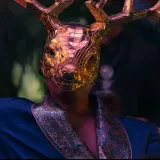Case File #033: The Enfield Poltergeist – Britain’s Most Documented Haunting
Status: Unresolved – Paranormal Activity Disputed
Date Filed: August 30, 1977
Last Reviewed: August 9, 2025
Location: Enfield, London, England, United Kingdom
Subjects: Hodgson Family – Janet (11), Margaret (13), and Peggy Hodgson (Mother)
Filed Under: Poltergeist Activity – Paranormal Investigation – Cultural Impact
Access Level: Public
Introduction: A Suburban Home Turns into a Media Sensation
In late summer 1977, a council house in Enfield, North London, became the center of one of the most infamous and extensively documented hauntings in history. Over 18 months, the Hodgson family reported furniture moving by itself, knocking on walls, voices emanating from nowhere, and even levitation.
The case quickly drew the attention of journalists, paranormal investigators, and skeptics alike. While many dismissed the events as a hoax, the Enfield Poltergeist remains one of the best-known hauntings in Britain — cemented in public memory through photographs, audio recordings, and later dramatizations in film and television.
The Family
Peggy Hodgson, a single mother, lived at 284 Green Street with her four children: Margaret, Janet, Johnny, and Billy. Life was typical until late August 1977, when strange disturbances began, centering primarily around Janet, the second-youngest child.
The First Night
On August 30, Janet complained that her bed was “shaking.” Her mother dismissed it as a bad dream — until the next evening, when she entered the girls’ room to find a chest of drawers sliding across the floor unaided. When Peggy tried to push it back, it felt as if an invisible force resisted her.
Escalation and Police Involvement
Within days, knocking sounds echoed through the walls. Toys flew across rooms. Neighbors witnessed the disturbances. Peggy contacted the police, and officers arrived on September 1, 1977. Constable Carolyn Heeps reported seeing a chair move several feet without anyone touching it — a statement documented in her official report.
Paranormal Investigation
The Society for Psychical Research (SPR) assigned investigators Maurice Grosse and Guy Lyon Playfair to the case. Over the next year, they recorded:
- Objects flying through the air without apparent cause
- Disembodied voices, including a deep male voice identifying itself as “Bill Wilkins” — later traced to a man who had died in the house years before
- Janet appearing to levitate in mid-air, captured in a series of photographs by Daily Mirror photographer Graham Morris
- Sudden drops in temperature and inexplicable equipment malfunctions
More than 30 independent witnesses — including neighbors, journalists, and investigators — reported seeing or hearing unexplainable events.
Skepticism and Accusations of Hoax
Not all believed the phenomena were genuine. Skeptics argued that the girls, particularly Janet, faked many incidents for attention. On some occasions, investigators caught the children bending spoons or throwing objects when they thought no one was looking.
However, even critics admitted that some recorded events — particularly those witnessed by police and journalists — remained difficult to explain.
The Cultural Impact
The Enfield case became a media phenomenon, covered in newspapers and television throughout the late 1970s. Its notoriety endured:
- Inspired documentaries such as The Enfield Haunting (2015)
- Served as a major influence for The Conjuring 2 (2016), where Ed and Lorraine Warren — who briefly visited the Enfield house — were portrayed as central investigators
- Continues to be cited in debates about the existence of poltergeists and the reliability of eyewitness testimony in paranormal cases
Theories
- Genuine Poltergeist Activity – Supporters argue the case is among the strongest evidence for poltergeist phenomena, citing multiple independent witnesses and physical recordings.
- Psychological & Emotional Stress – Some researchers believe the activity was a manifestation of the children’s subconscious stress, amplified by media attention.
- Partial Hoax – A middle-ground theory suggests some events were genuine while others were staged by the children to maintain attention once the story gained publicity.
- Complete Fabrication – Skeptics contend all phenomena were faked, pointing to moments of proven trickery.
Aftermath
By 1979, the activity had largely ceased. Janet later admitted that “some” incidents were fabricated, but maintained that most were real. Peggy Hodgson lived in the house until her death in 2003, still insisting the haunting was genuine. The property has since changed hands multiple times, with some later occupants reporting nothing unusual — while others claimed strange occurrences continued.
Conclusion: Between Belief and Skepticism
The Enfield Poltergeist stands at the crossroads of paranormal folklore and investigative skepticism. It remains one of the most heavily documented hauntings, complete with police reports, photographs, and hours of audio evidence — yet it offers no definitive proof of the supernatural.
Whether it was a genuine case of poltergeist activity, a family under stress, or a blend of both, the events at 284 Green Street continue to fascinate believers and skeptics alike.
References
All sources used in this case are listed in the References Archive. Each link corresponds to verified witness accounts, official statements, and documented investigative reports.

